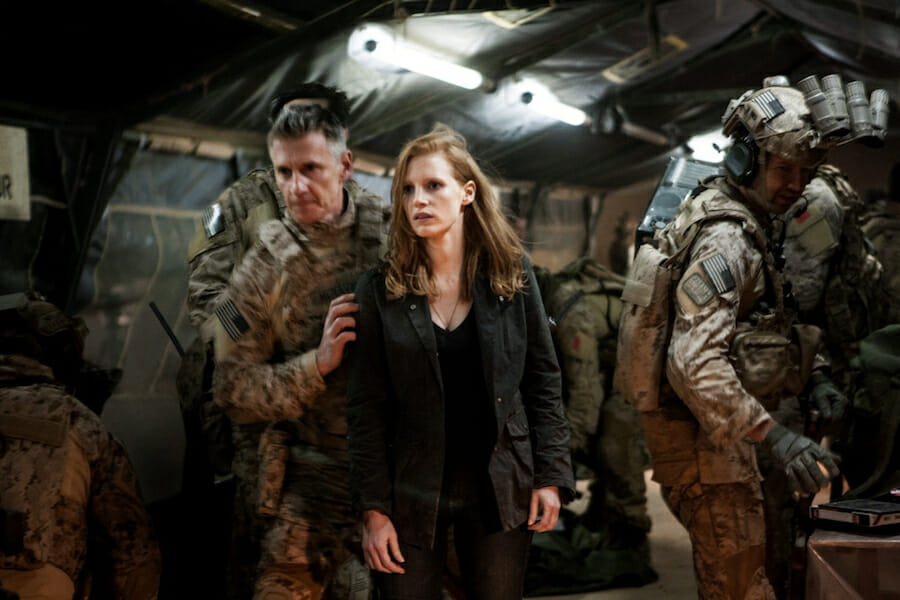
Review of Kathryn Bigelow’s ‘Zero Dark Thirty’: The Hunt for bin Laden
Kathryn Bigelow’s Zero Dark Thirty opens with an “enhanced interrogation” (the polite term for torture) of a Pakistani terrorist who has already been badly beaten by a CIA agent named Dan. Enter Maya, a new CIA agent and central character in the film, just off the plane in her best black suit. Maya, a willowy gorgeous intense redhead, seemingly unburdened by a sense of humor or maidenly vapors, does appear briefly overwhelmed by the violence of the scene before her but insists they return to the session even after a coffee break. She is not to be deterred. Maya says insistently, “we should go back in!” and charges back into the interrogation room, snapping at the bit.
The suspect is held down, mouth flooded with streams of water filtered through what looks like a sock, gagging and choking and trying to scream. It can’t be called anything but torture, waterboarding, and it is quite horrible for the viewer especially when you realize that this is standard operating procedure. And no one in charge of covert operations feels it necessary to justify it. In fact, it is also called “justifiable violence.” Or simply business as usual. These scenes of individual torture by the US are contrasted with shots of mass Al Qaeda terrorist attacks on September 11 in New York and in London years later. The body count is detailed and the visuals are dreadful even though we ought to be accustomed to them by now.
Is this an attempt to justify the scenes of torture? Probably not but it is instructive as a comparison – it’s a numbers game – perhaps one can say that inflicting brutality on one possible Al Qaeda agent in the attempt to obtain vital information is justifiable in the wake of a mass attack which took the lives of hundreds of innocent civilians. There is no debate, these CIA agents just get on with what has become their business – extracting truth any way they can.
As a footnote to the torture scene, Dan and a fellow agent later compare notes on Maya. “DC says she’s a killer.”
By the end of this scene we are inclined to believe it – they all are. The hapless terrorist suspect asks her how he can help himself possibly hoping that as she is a woman she will be compassionate- and her response, utterly undiluted by compassion, face frozen in a stern mask, is a clipped “You can help yourself by being truthful.”
We are repeatedly reminded that the film is based on real life encounters and narratives. If not for this, we would sometimes feel the distinct pressure of a leg-pull. Lead torturer Dan has several cages full of experimental animals, beautiful grey monkeys who are very close to him – they eat from the same ice cream cones. But the monkeys can’t survive without Dan’s protection. After Dan decides to return to the United States, he tells Maya, “Maya, they killed my monkeys.” In a rare display of gentleness she says, “Sorry Dan.” Discussion closed.
The scene of the Pakistani suspect and the CIA agent and the waterboarding is the opening drama. Bigelow aims to tell the truth about how the CIA agents find the truth, whether through boots on the ground sleuthing or cell phone tracing or through “enhanced interrogation.” But the overall feeling one gets, aside from revulsion at the violence, is the cell’s total weariness—it was a long stretch of time from September 11 to May 1, 2011, the day that U.S. special forces stormed bin Laden’s compound in Abbottabad, Pakistan, a stretch full of foiled attempts, budget battles, political infighting and Barack Obama maintaining that the United States does not use torture.
Into the bleak environment comes Maya, played by Jessica Chastain, and she is indeed a killer. Despite her beauty, she is tireless, relentless, an exceedingly powerful warrior ceaselessly watching the heat signatures of bin Laden’s courier and his family, and finally someone whom she thinks is bin Laden himself, inside the compound.
Her tireless discoveries ultimately take U.S. soldiers via dark muted choppers into bin Laden’s compound, suited up in bizarre spaceman outfits of four flashlight eyes in a helmet, whose suits are festooned with bombs which can be peeled off and attached to a site to explode it. The soldiers systematically destroy the compound floor by floor and then in a brutal shootout they find their target.
It’s hard to be objective about this film. It was so violent that it induced nausea. And yet it was so powerful, particularly the figure of Maya, and let’s face it, righteous, that we continued to be glued to the screen at the climax—the opening of the body bag containing the remains of the three Pakistani families. The family documents were retrieved separately.
There was no passport, which would aid ID. The soldiers slowly turned to Maya for “direct visual confirmation” that the last body in the bag was bin Laden. She nodded slowly, tears streaking down her face.
Zero Dark Thirty is a film about war, violence, what is justifiable in war, what happens when violence becomes a way of daily life on both sides. It escalates until it is unbearable. You can’t take your eyes off this movie. It is cold, direct, unsentimental, and yet there are fleeting touches of humanity throughout. And pity- it was Dan’s colleagues, his fellow CIA, who killed all those monkeys. They are all killers. No question but that this is Oscar territory and justly deserved.

